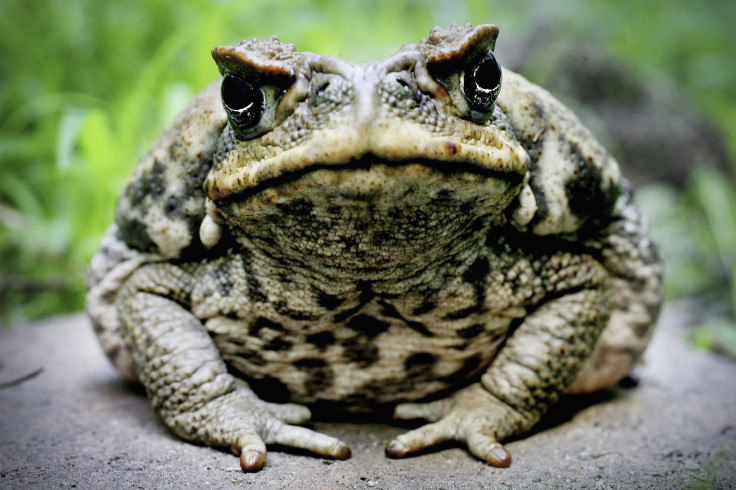Photo Of ‘Horny’ Cane Toads Trying To Mate With Python Goes Viral

After the rare photograph of poisonous cane toads riding on the back of a python went viral on Twitter, Sunday, it was revealed that the amphibians in Australia, were in fact trying to mate with the reptile.
The picture of the rare sight was shared by Andrew Mock, while writing this article and was “liked” over 4,000 times and retweeted over 1,500 times. Mock’s brother, Paul Mock, who lives in the remote West Australian town of Kununurra, was the one who witnessed the unusual moment when he got up in the middle of the night to check on the condition of the dam and its spillway after a huge storm swept through the area.
68mm just fell in the last hour at Kununurra. Flushed all the cane toads out of my brothers dam. Some of them took the easy way out - hitching a ride on the back of a 3.5m python. pic.twitter.com/P6mPc2cVS5
— Andrew Mock (@MrMeMock) December 30, 2018
A video of the incident was obtained by the Guardian:
“The lake was so full it had filled the cane toad burrows around the bank and they were all sitting on top of the grass – thousands of them,” Paul told Guardian Australia. “He was in the middle of the lawn, making for higher ground. ‘He’ was Monty [a nickname given by Paul and his family], a 3.5m resident python also fleeing the rising water, only with a band of cheeky travelers on board. He was literally moving across the grass at full speed with the frogs hanging on. I thought it was fascinating that some of the local reptiles have gotten used to [the cane toads] and not eating them.”
Attempting to explain why the toads were riding the python, conservation biologist Jodi Rowley said that the amphibians were not only trying to snake a ride, but trying to mate with the reptile.
“This is one of the most amazing videos I've seen!! Lots of *very* horny Cane #Toads (Rhinella marina) trying to mate with a large Olive #Python (Liasis olivaceus), with Giant Burrowing Frogs (Cyclorana australis) & Red Tree #Frogs (Litoria rubella) calling in the background!” she said.
She also tweeted the photo of another very bizarre scenario, where the same toads were trying to mate with a rotten mango:
Male Cane Toads often get a bit carried away. This AMAZING video reminds me of the time I found a Cane Toad trying to mate with a rotting mango in North Queensland! 🤣 pic.twitter.com/g2kUBvOUV1
— Jodi Rowley (@jodirowley) December 31, 2018
Although cane toads – the largest toads in the world which carry toxins, which can be harmful for humans and deadly for small animals - are native to South and Central America, they are also found in several parts of Australia. Olive pythons, on the other hand, are non-venomous and harmless to humans.
Paul told ABC News that people living in the area, don’t normally know about the population of cane toads because, the burrows built by them surrounding the lake, don’t often get flooded.
"It's staggering how many are there. I didn't realize how many are hiding there until they all got flushed out," he said. “They are nocturnal and come out at night mainly, they don't like the heat, they love the rain. They were all breeding like mad last night, fighting over females, so it was quite a sight to behold."
He also had quite a few stories to share about the snake, the toad was riding. “We're often seeing him around the clothesline and in the bush. The last major encounter we had with him was when he had eaten a wallaby. And he was so full, he couldn't move. We could actually go up and touch him. He was pretty agro [aggressive] about being touched because he was basically helpless and vulnerable because he had such a full belly,” he added.
Paul said that he was glad that harmless snakes like olive pythons, had found out a way to co-exist with cane toads. "It's encouraging in a way to know the snake's smart enough not to eat them and is surviving, and they're living together and getting on with each other," he said.
© Copyright IBTimes 2025. All rights reserved.






















